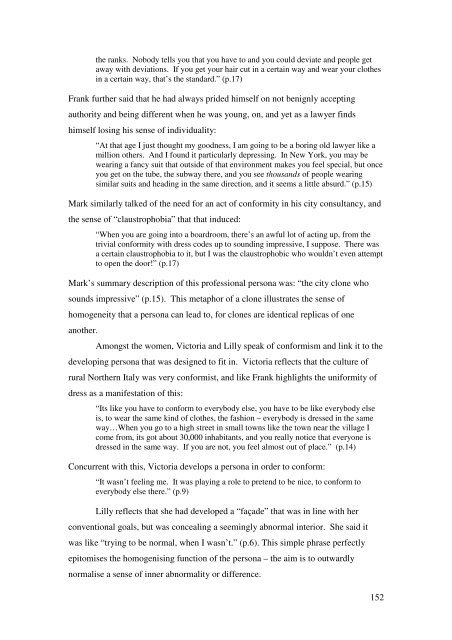DEVELOPMENTAL CRISIS IN EARLY ADULTHOOD: A ...
DEVELOPMENTAL CRISIS IN EARLY ADULTHOOD: A ...
DEVELOPMENTAL CRISIS IN EARLY ADULTHOOD: A ...
You also want an ePaper? Increase the reach of your titles
YUMPU automatically turns print PDFs into web optimized ePapers that Google loves.
the ranks. Nobody tells you that you have to and you could deviate and people get<br />
away with deviations. If you get your hair cut in a certain way and wear your clothes<br />
in a certain way, that’s the standard.” (p.17)<br />
Frank further said that he had always prided himself on not benignly accepting<br />
authority and being different when he was young, on, and yet as a lawyer finds<br />
himself losing his sense of individuality:<br />
“At that age I just thought my goodness, I am going to be a boring old lawyer like a<br />
million others. And I found it particularly depressing. In New York, you may be<br />
wearing a fancy suit that outside of that environment makes you feel special, but once<br />
you get on the tube, the subway there, and you see thousands of people wearing<br />
similar suits and heading in the same direction, and it seems a little absurd.” (p.15)<br />
Mark similarly talked of the need for an act of conformity in his city consultancy, and<br />
the sense of “claustrophobia” that that induced:<br />
“When you are going into a boardroom, there’s an awful lot of acting up, from the<br />
trivial conformity with dress codes up to sounding impressive, I suppose. There was<br />
a certain claustrophobia to it, but I was the claustrophobic who wouldn’t even attempt<br />
to open the door!” (p.17)<br />
Mark’s summary description of this professional persona was: “the city clone who<br />
sounds impressive” (p.15). This metaphor of a clone illustrates the sense of<br />
homogeneity that a persona can lead to, for clones are identical replicas of one<br />
another.<br />
Amongst the women, Victoria and Lilly speak of conformism and link it to the<br />
developing persona that was designed to fit in. Victoria reflects that the culture of<br />
rural Northern Italy was very conformist, and like Frank highlights the uniformity of<br />
dress as a manifestation of this:<br />
“Its like you have to conform to everybody else, you have to be like everybody else<br />
is, to wear the same kind of clothes, the fashion – everybody is dressed in the same<br />
way…When you go to a high street in small towns like the town near the village I<br />
come from, its got about 30,000 inhabitants, and you really notice that everyone is<br />
dressed in the same way. If you are not, you feel almost out of place.” (p.14)<br />
Concurrent with this, Victoria develops a persona in order to conform:<br />
“It wasn’t feeling me. It was playing a role to pretend to be nice, to conform to<br />
everybody else there.” (p.9)<br />
Lilly reflects that she had developed a “façade” that was in line with her<br />
conventional goals, but was concealing a seemingly abnormal interior. She said it<br />
was like “trying to be normal, when I wasn’t.” (p.6). This simple phrase perfectly<br />
epitomises the homogenising function of the persona – the aim is to outwardly<br />
normalise a sense of inner abnormality or difference.<br />
152
















